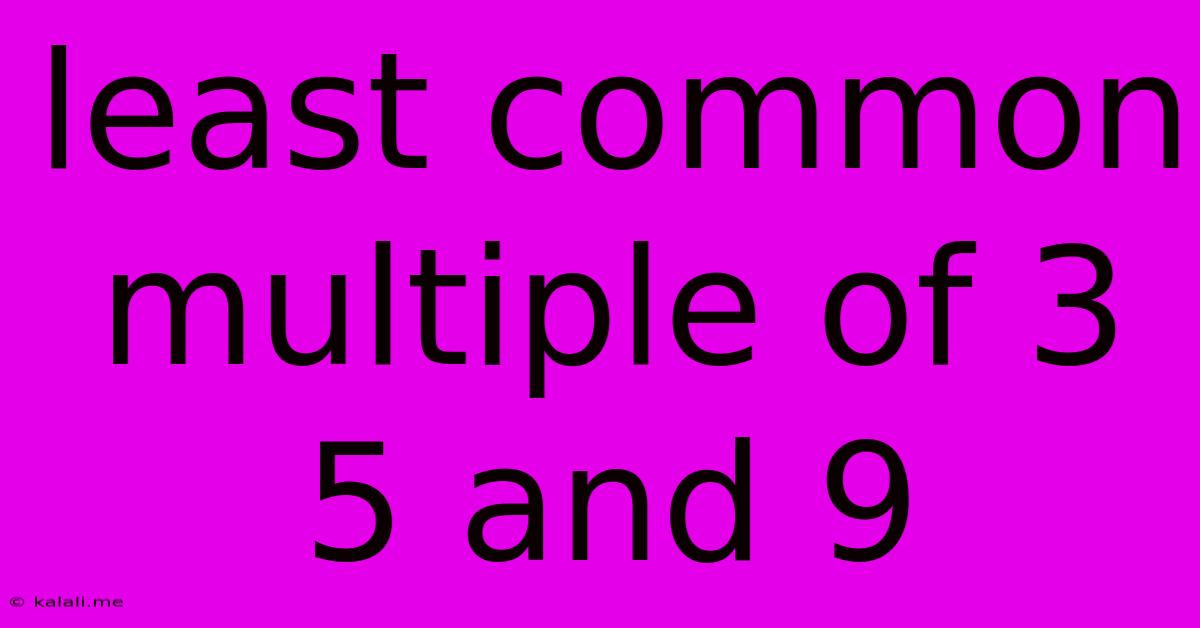Least Common Multiple Of 3 5 And 9
Kalali
Jun 13, 2025 · 3 min read

Table of Contents
Finding the Least Common Multiple (LCM) of 3, 5, and 9
Finding the least common multiple (LCM) is a fundamental concept in mathematics, particularly useful in simplifying fractions and solving problems involving cycles or periodic events. This article will guide you through calculating the LCM of 3, 5, and 9, explaining the methods involved and offering a deeper understanding of the concept. Understanding LCM is crucial for various mathematical applications, from simple fraction addition to more complex algebraic manipulations.
What is the Least Common Multiple (LCM)?
The least common multiple (LCM) of two or more integers is the smallest positive integer that is divisible by all the integers. In simpler terms, it's the smallest number that all the given numbers can divide into evenly without leaving a remainder. This concept is often used alongside the greatest common divisor (GCD) in various mathematical problems.
Methods for Finding the LCM of 3, 5, and 9
There are several ways to determine the LCM of 3, 5, and 9. Let's explore two common methods:
1. Listing Multiples Method
This method involves listing the multiples of each number until you find the smallest multiple common to all three.
- Multiples of 3: 3, 6, 9, 12, 15, 18, 21, 24, 27, 30...
- Multiples of 5: 5, 10, 15, 20, 25, 30, 35...
- Multiples of 9: 9, 18, 27, 36, 45, ...
By comparing the lists, we can see that the smallest multiple common to 3, 5, and 9 is 45. Therefore, the LCM(3, 5, 9) = 45. This method is straightforward for smaller numbers but can become cumbersome with larger numbers.
2. Prime Factorization Method
This method is more efficient, especially for larger numbers. It involves finding the prime factorization of each number and then constructing the LCM from the highest powers of each prime factor.
- Prime factorization of 3: 3 = 3¹
- Prime factorization of 5: 5 = 5¹
- Prime factorization of 9: 9 = 3²
To find the LCM, we take the highest power of each prime factor present in the factorizations:
- The highest power of 3 is 3².
- The highest power of 5 is 5¹.
Therefore, the LCM(3, 5, 9) = 3² * 5¹ = 9 * 5 = 45. This method is generally preferred for its efficiency and applicability to larger numbers.
Applications of LCM
Understanding and calculating the LCM has practical applications in various fields:
- Fraction addition and subtraction: Finding a common denominator for fractions requires finding the LCM of the denominators.
- Scheduling problems: Determining when events with different periodicities will coincide (e.g., buses arriving at a stop).
- Modular arithmetic: Solving congruences and other problems in number theory.
Conclusion
The least common multiple (LCM) is a crucial mathematical concept with diverse applications. Both the listing multiples and prime factorization methods provide effective ways to calculate the LCM, with the prime factorization method offering greater efficiency for larger numbers. Understanding the LCM is essential for anyone working with numbers and their relationships. In this case, we've definitively shown that the LCM of 3, 5, and 9 is 45.
Latest Posts
Latest Posts
-
Snake In The Grass Meaning Idiom
Jun 14, 2025
-
What Is The Lcm Of 4 8 10
Jun 14, 2025
-
Which Statement About Energy Is Correct
Jun 14, 2025
-
Who Is Considered The Father Of The Modern Olympic Games
Jun 14, 2025
-
Act Score For University Of Maryland
Jun 14, 2025
Related Post
Thank you for visiting our website which covers about Least Common Multiple Of 3 5 And 9 . We hope the information provided has been useful to you. Feel free to contact us if you have any questions or need further assistance. See you next time and don't miss to bookmark.